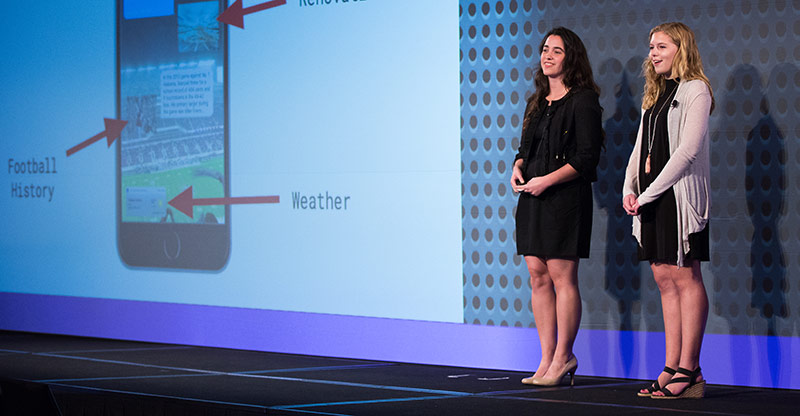Last October Texas A&M students Jordan Sales and Elise Hackney stepped into the lobby of the NAB Futures convention awestruck at the opportunity to share and showcase their idea to established professionals in the industry. Their application, History Go, is an augmented reality app that displays historic images and facts and won second place in last year’s NAB Pilot Innovation Challenge.

Jordan Sales and Elise Hackney presenting their idea at NAB Futures 2016.
“It was amazing walking into the innovation conference. We were surrounded by these really amazing and intelligent people,” said Sales, an English major at Texas A&M. “There is no presentation or interview that we can get that is as cool, exciting or nerve wracking as the Innovation Challenge.”
Two months prior to NAB Futures, Sales and Hackney were brainstorming together in Dr. Rodney Hill’s Design Process 101 class. The first project assigned in Dr. Hill’s class was a product development idea that had to be submitted to a national competition.
For the 2016 Innovation Challenge, entrants were asked “How might local television and radio broadcasters engage their communities with next-generation content on any device, whether big, small or moving?”
Sales and Hackney were drawn to the flexible and simple guidelines of the Innovation Challenge. “We were really excited by the idea [of creating] new forms of media for the next generation,” Sales said. “Other challenges were very specific in their requirements. The PILOT Innovation Challenge gave us a chance to be more open-ended in our approach.”
With the competition selected, Sales and Hackney came together with four other students ranging in class levels and disciplines from English to mechanical and material engineering. The idea for History Go spurred from the students’ use of their phones for news and information. History Go brings history to life with the help of a cell phone and augmented reality.
As a freshman mechanical engineering major, having the encouragement of professionals helped Hackney not only present in front of a crowd by also gave her and Sales the confidence to continue their project further.
“Being a freshman college student and having this moment so early on was amazing,” Hackney said. “I got nervous, but after presenting it gave me a sense of confidence.”
So what is next for History Go? After coming in second, History Go’s team received $15,000 to assist with prototyping as well as access to key broadcast executives and exclusive exposure at industry events, such as NAB Show New York and NAB Show.
In the last year, the History Go team has met with professionals they met through the Innovation Challenge. For two young women now thrown into the world of innovation and creation, it was encouraging for Sales and Hackney to meet so many female professionals and peers in the competition.
“All of the finalist were women,” Hackney said. “Being told my ideas were cool, it was amazing seeing other women that have done it too.”
Sales and Hackney have taken on the initiative to move History Go forward and have enrolled in Texas A&M incubator Startup Aggieland. They plan to start with the history of the Texas A&M campus and surrounding town, which would not have been possible without the Innovation Challenge, Hackney said. Sales and Hackney are thankful for their experience in the PILOT Innovation Challenge and encourage others to take the leap.
“Don’t be nervous about it,” Sales said. “Appreciate the opportunity to be there. Realizing that this is a fun place to talk about an idea that you are passionate about. This is a place to grow that idea.”
History Go team: Eric Asencio, Mike Le, Claire Lohn, Jordan Sales, Elise Hackney and Alberta Lin.

